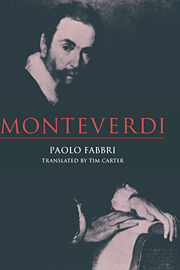Introduction
Published online by Cambridge University Press: 05 May 2010
Summary
In the decade following his death, Monteverdi's name remained prominent in the musical world. Publishers - and not just Italians - reprinted his works or, and preferably, presented hitherto unpublished music in anthologies and above all in single volumes wholly devoted to his compositions. There were revivals of his operas, as with the staging of La coronatione di Poppea in Naples in 1651 with the title Nerone (the libretto was printed there in the same year by Roberto Mollo) and perhaps elsewhere. Nor do we lack acknowledgments of his standing by important musicians, such as the maestro di cappella of the French royal chapel, Thomas Gobert, who when writing to Costantin Huygens in 1646 could cite ‘some madrigals composed by Monteverdi’ as an example of the most enchanting ‘Italian manner’: Gobert particularly admired ‘his search for and exploration of many beautiful chords and dissonances’. Similarly, Heinrich Schiitz, in the preface to his Symphoniarum sacrarum secunda pars (1647), made clear the personal debt arising from his having encountered the composer of the Madrigali guerrieri, et amorosi. And for the rest, it is an indication of Monteverdi's popularity in Austria and Germany - to which we shall return - that he was included in the Tractatus compositionis augmentatus by Schiitz's pupil, Christoph Bernhard (1627-92). Here Monteverdi is cited together with his pupils Giovanni Rovetta and Francesco Cavalli in Chapter 43, ‘Von der Imitation’, as standing among the representatives of the ‘stylus luxurians comunis’ (‘common luxuriant style’) and of the ‘stylus [luxurians] teatralis’ (‘theatrical luxuriant style’).
- Type
- Chapter
- Information
- Monteverdi , pp. 1 - 5Publisher: Cambridge University PressPrint publication year: 1994
- 1
- Cited by



